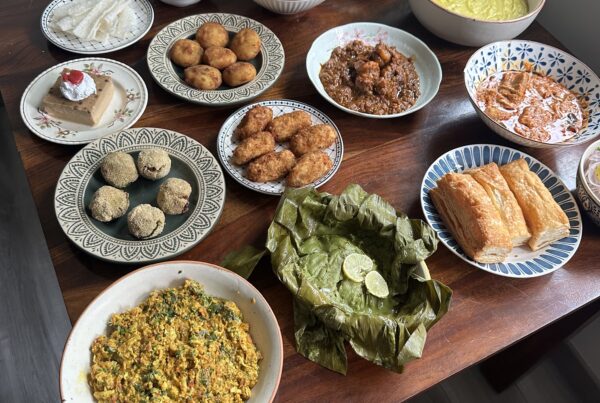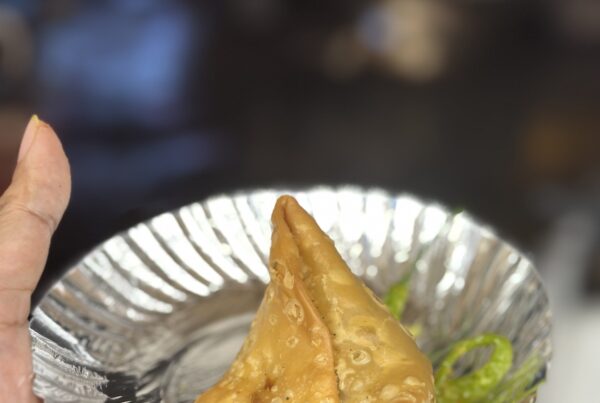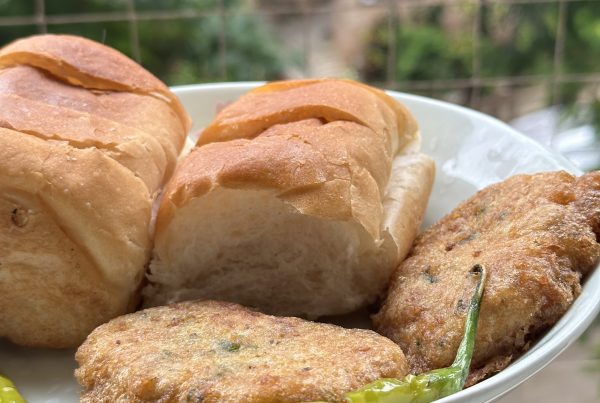 |
| Presented by moghlai paratha master Shaswati Saradar. (The hand is mine) |
Our friend Shaswati made moghlai parathas for K & me last night. Just as she had when she first invited us over to her place and cooked for us. That was more than 3 years back. She has fed us many lovely meals since.
The parathas came piping hot. I took a knife and fork and cut mine into ‘squares.’ The way our elders would when they took us to the corner restaurants of Kolkata when we were kids and ordered it for us. This was as special as treats would get.
‘Easier to eat,’ I explained to Kainaz.
Those rather nondescript places would serve the food on bone china with tiny, twisted, polka (flimsy) metal knives and forks. The squares made it easy for us.
Shaswati had made the potato sabzi which is de rigueur with this dish, just as an Uttam Kumar movie is incomplete without Suchitra.
I asked for some shosh (ketchup) and kasundi (the sensational runny, pungent mustard sauce that runs in the blood of us Bengalis) on the side. Not that the paratha needed any help, but these condiments completed the taste experience as dictated by nostalgia. The only thing missing was the ‘salad’ served on the side.’ Roughly julienned onion, beet, cucumber and carrots. Cut well in advance and plonked on the plate in a world where we were braver. A world with no bottled water, sanitiser or masks. Or reckless.
“This is a snack? Not dinner?” asked K incredulously.
“Yes, we would eat this in the evening,” answered Shas and me both.
“Dinner would be rice or roti, dal, veg, fish or egg curry,” I added.
Shaswati’s Moghlai parathas, which she apparently learnt to make when she was in the 7th or 8th standard i.e. early teens, is not the ‘authentic’ roadside ‘cabin’ one. Hers is stuffed with minced meat which is enveloped by the maida casing, which is then fried with an egg coating. In the cabin parathas there would just be the ‘essence of meat.’ This made hers a lot more filling. Plus hers is meticulously shallow fried which renders the parathas diaphanous and crisp, versus the roadside ones which would be deep fried in a hurry and would be more doughy and crunchy.
The former more like a crisp white panjabi (kurta) with gile kora hata (crimped sleeves) and botam (cuff links) which one would wear along with a white dhuti for a wedding. The latter more like a rough khaadi panjabi, whose sleeves one would roll up, and wear with jeans to college. Figuratively speaking!
Well that sums up the story of home cooking versus street food. Both create unforgettable moments, albeit of a different kind. What is important is to live in the moment and enjoy your moghlai paratha. Especially when it is so exquisite!




Are you sure about the cufflinks with the panjabi? 🙂 My father used to wear panjabi'r botam in gold. It used to be a big deal to gift your new jamai with gold or even diamond buttons, a mandatory gold chain and a ring.
The moghlai porota looks so sumptuous! Shaswati di must be a genius to master these in class 7 or 8! I still cannot get that envelop fold right!
Hirer botam, hirer aangti for hirer tukro chhele :p But I don't think cuff link with panjabi is possible